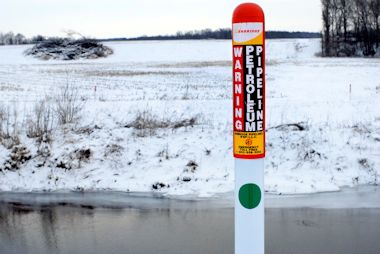
Photo by Clare Howard A warning post set in the west bank of Walnut Creek in Woodford County designates the location where the Enbridge Flanagan South pipeline is buried beneath the creek. The crossing should be considered a “high consequence area” according to Illinois State University Professor Angelo Capparella who has studied pipelines and their environmental risks.
Central Illinois is now a major transportation route for Canadian Tar Sands crude oil, with Enbridge Inc. sending up to 880,000 barrels a day through pipeline constructed above the Mahomet Aquifer. The Mahomet supplies ground water for residents in 14 counties in central Illinois.
“Anything that reaches the aquifer would create a huge problem. We would lose the use of that groundwater. That is risking a resource more precious than oil,” said Angelo Capparella, associate professor, School of Biological Sciences at Illinois State University.
The pipeline runs above the northwest edge of the Mahomet in an area where the level of the aquifer is higher and closer to the pipeline.
Unlike traditional oil, tar sands oil can cause more pollution because it sinks rather than floats. The Enbridge pipeline spill in 2010 into the Kalamazoo River required extensive removal of streambed soil to recover impregnated oil. Some scientists believe even with this extensive cleanup remediation will never be complete.
Charles and David Koch own hundreds of wells in Alberta, Canada, and hundreds of miles of pipeline that transport Canadian tar sands crude, according to a report published in Inside Climate News. Koch investments in Canadian tar sands go back 50 years. Koch Industries’ Pine Bend Refinery in Minnesota is responsible for 20 percent of tar sands oil shipped to the United States and growing dependence on tar sands imports is expected to boost Koch profits even further. Crude from the Koch brother’s Pine Bend refinery is sent south and links with Enbridge’s Flanagan South Pipeline, according to the Bakken Oil Report.
“Pipelines have been so deregulated by Congress in recent years. Companies have been given an open book policy to do what they want,” Capparella said. “Environmental reviews have been pretty lax to say the least.”
Capparella used the Freedom of Information Act to request copies of environmental reviews from the Illinois Department of Natural Resources, sometimes filing repeatedly to obtain information.
“I have been shocked at how minimal the reviews were,” he said.
Of particular concern are sensitive areas like streams. Capparella said such a crossing can be ruled an HCA or “high consequence area” and should receive special engineering and monitoring.
One stream crossing is on land owned by organic farmer Henry Brockman. Scores of trees were cut on the Brockman property and an adjacent farm where the pipeline runs under Walnut Creek.
Brockman and other farmers in the area said they were never informed the pipeline was for Canadian Tar Sands Crude. A spokeswoman for Enbridge says all property owners were informed.
Doug Hayes, attorney for the Sierra Club, said, “We have a strong case that the government deliberately segmented the project to avoid an environmental review.”
He expects to prove the pipeline violates the Clean Water Act and the National Environmental Policy Act.
Hayes said oil corporations saw the controversy surrounding Keystone XL and deliberately planned and constructed the pipeline through central Illinois “behind closed doors.” The company had legal right of eminent domain, he said, but misrepresentation could constitute fraud.
“Public review was deliberately avoided,” Hayes said.
Oral arguments in the case are scheduled for April 9 in U.S. Circuit Court of Appeals in Washington, D.C.
The U.S. Environmental Protection Agency filed an objection with the U.S. Army Corps of Engineers over concern for waterways, Hayes said.
Another issue that concerns Capparella is lack of public disclosure. He said that puts first responders and landowners at greater risk should a leak occur, and he noted that Enbridge has a corporate history of leaks.
He cited the Enbridge pipeline leak into the Kalamazoo River. Because first responders and landowners did not know the toxicity of tar sands oil, they were undoubtedly exposed to dangerous toxins referred to as volatile organic compounds, he said, noting that tar sands oil has a greater problem with increased potential for caustic spills.
Capparella, who has devoted years to researching the environmental risks of pipelines, said, “I’m more concerned about the incompetence of companies versus terrorists. All spills have been due to corporate incompetence.”

Recent Comments